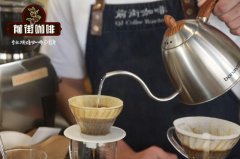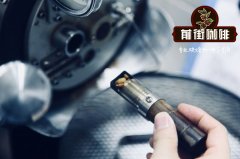Coffee roasting machine to better roast coffee beans roasting temperature and time with roasting machine

Professional coffee knowledge exchange more coffee bean information please follow the coffee workshop (Wechat official account cafe_style)
Coffee roasting _ coffee bean roasting _ coffee roasting training
If the coffee roaster knows the structure of the roaster he uses, he can effectively control the whole roasting process. Coffee roasting is a process in which raw beans (Green Bean) are transformed into the flavor of ripe beans (Roast Bean) by heat generation of Non-Enzymatic Browning.
one
Heat is a kind of physical energy that is measurable and proportional to temperature. The heat in the roasting process plays a leading role in the change of coffee flavor, so it can be said that understanding heat is tantamount to understanding baking. However, heat is difficult to quantify, and it is impossible to use exactly the same amount of heat for each baking. Therefore, it is important for bakers to understand the types, functions and differences of heat in order to maintain a complementary relationship.
The types and understanding of Heat
The heat used in baking can be divided into convection (convection), conduction (conduction) and radiation (radiant). Each roaster uses a different ratio. In the case of a general drum roaster (Solid Drum), the drum is heated by a combustion furnace, and the raw beans in the drum are absorbed by convection and conduction.
For example, Probat's Type-1 uses conduction 2: convection 8, but the new Type-2 uses almost 100% convection.
The W6 model of Giesen uses conduction 4: convection 6, while the W15 model uses conduction 1: convection 9.
2 ▲ Probat,Giesen
Conduction is the transfer of heat from the higher temperature part of the object to the lower temperature part of the object, and the heat transfer rate to the raw bean is slow. After the beginning of baking, the conduction accounts for a large proportion in the endothermic process of raw beans. However, overheating of the drum can lead to Scorching.
Convection is a process in which heat transfer is realized by the macroscopic flow of gases or liquids. Convection is better and more uniform than heat conduction. The proportion of heat transfer to raw beans is the most in the whole baking process. However, poor exhaust balance can lead to baking time being too fast or too slow.
Radiation (radiant) is emitted in the form of electromagnetic waves and particles, and heat transfer can be carried out without a medium. The external and internal heat transfer of raw beans is uniform, but it is difficult to control and accounts for a small proportion in actual baking.
three
Types of ▲ heat
Types and characteristics of combustion furnace (Lamp)
The combustion furnace of the roaster can be divided into two furnaces, environmental furnace (Environment-Lamp) and infrared furnace (Infrared-Lamp).
The flame of the environmental furnace (or gas furnace) is blue and the height is low. It is used by most commercial roasters. The taste is characterized by good sour taste and heavy feeling (Body).
The flame of the infrared furnace is red and has no height. The representative roaster using this furnace is Diedrich of the United States. The taste is characterized by a balance between sour and sweet taste.
four
Infrared furnace, gas furnace
Drum (Drum) and heating method
The structure of drum roaster (Solid Drum) is that there is a combustion furnace under the drum. Therefore, single-layer drum (Single Drum), it is easy to produce scorch (Scorching) phenomenon. In order to avoid this problem, some roasters install a heat dissipation plate between the combustion furnace and the drum, but this can not control the heat of the heat dissipation board, and it is not easy for the baker to control the roaster.
The double-layer drum (Double Drum) is made of two steel plates, and some of the outer and inner plates are made of different materials. Because of the double-layer plate, the conduction heat is lower and the chance of scorching is also low. Therefore, the baking result of double-layer drum is more uniform and stable than that of single-layer drum.
five
Double drum, single drum
The roaster with 100% convection (hot air type) will not directly heat the drum, so coke burning will hardly occur. The baking curve of this roaster is HTST (High Temperature Short Time), the baking time is high, and the production efficiency is high. The representative roaster in this way is the Loring of the United States. The taste is characterized by high sour taste and low Body.
Thus it can be seen that the heat transfer ratio and mode of each roaster is different, and the coffee roaster should know the structure and characteristics of the roaster to apply it. The more the roaster knows the details, the more finished the coffee will be.
Coffee baking software Artisan Chinese version downloads coffee baking curve software
Important Notice :
前街咖啡 FrontStreet Coffee has moved to new addredd:
FrontStreet Coffee Address: 315,Donghua East Road,GuangZhou
Tel:020 38364473
- Prev

Home-made coffee techniques and dress code can become Home Barista in ten steps.
Professional coffee knowledge exchange more coffee bean information please follow the coffee workshop (Wechat official account cafe_style) hand-brewed coffee tutorials _ hand-brewed coffee video _ hand-brewed coffee skills and proportions there is a set of dresscode (dress code) all over the world, such as black-tie for dinner, polo shirts for tennis, swimwear for swimming are all functional conventions.
- Next

Interpretation of the function of Coffee Baking Curve how to make and interpret the Baking Curve
Professional coffee knowledge exchange more coffee bean information please follow coffee workshop (Wechat official account cafe_style) coffee roasting _ bean roasting _ coffee roasting training in the fresh eyes, all the baking curves seem to be the same, but when you really understand it, the baking curve becomes a valuable tool. Whether you are a professional or amateur bean baker, baking music
Related
- Beginners will see the "Coffee pull flower" guide!
- What is the difference between ice blog purified milk and ordinary milk coffee?
- Why is the Philippines the largest producer of crops in Liberia?
- For coffee extraction, should the fine powder be retained?
- How does extracted espresso fill pressed powder? How much strength does it take to press the powder?
- How to make jasmine cold extract coffee? Is the jasmine + latte good?
- Will this little toy really make the coffee taste better? How does Lily Drip affect coffee extraction?
- Will the action of slapping the filter cup also affect coffee extraction?
- What's the difference between powder-to-water ratio and powder-to-liquid ratio?
- What is the Ethiopian local species? What does it have to do with Heirloom native species?

